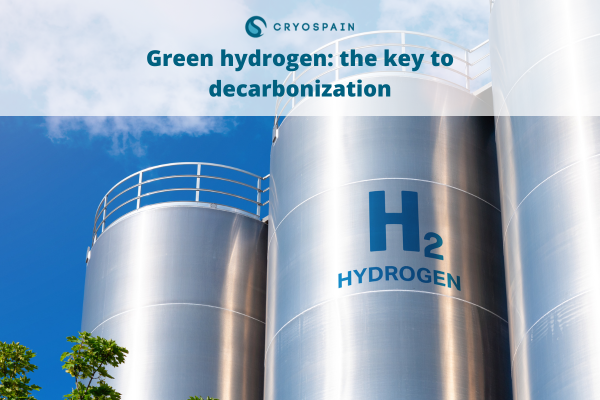Green hydrogen is currently at the center of global efforts toward decarbonization. Produced through a clean process using renewable electricity, it is a promising form of sustainable fuel capable of supporting numerous industries in their energy transition toward more low-carbon technologies.
This green fuel is expected to revolutionize a wide range of sectors, including mobility, energy and electricity, industrial production, and heating and cooling systems, among others.
However, the adoption of what is also known as renewable hydrogen has been partially limited due to the high costs of hydrogen production, the need for specialized infrastructure, and current limitations in achieving optimal energy efficiency.
Find out one of our projects: Green hydrogen and cryogenics: a new challenge for Cryospain
According to the International Energy Agency (IEA), global green hydrogen production in 2020 was around 0.2 million metric tons, representing only 0.1% of total global hydrogen output.
Still, in its report The Future of Hydrogen, the IEA forecasts rapid growth for the use of green hydrogen, driven by the increasing number of international projects and investments in electrolyzer technology and fuel cell technology. The main reason: its immense potential as a source of zero-emission energy and clean energy.
What is green hydrogen and how is it produced?
Green hydrogen refers to a type of hydrogen produced through a sustainable process that significantly reduces its environmental impact.
Specifically, it is obtained through the electrolysis of water, which involves using renewable electricity to split water into hydrogen and oxygen molecules. This process produces no carbon emissions, making it a form of zero-emission energy and a truly clean energy solution.
This marks a significant improvement over conventional hydrogen production methods, which typically rely on fossil fuels such as natural gas and coal. According to the IEA, traditional methods are responsible for 830 million tons of CO₂ emissions annually—equivalent to the combined emissions of the UK and Indonesia.
Advantages and challenges of green hydrogen
The unique benefits of green hydrogen make it a central player in the global push toward decarbonization:
- It is a source of clean energy, as it is derived from renewable hydrogen processes that emit no greenhouse gases.
- Its versatility allows it to be used in fuel cell vehicles, electricity generation, heating, industrial processes, and even maritime transport.
- It enables large-scale hydrogen storage, helping overcome intermittency issues commonly associated with other renewable sources.
Keep learning: Revolutionizing the aeronautical industry with liquid hydrogen
Despite these strengths, there are still challenges facing the broader adoption of green hydrogen:
- Currently, green hydrogen is more expensive than hydrogen produced from fossil fuels, though costs are expected to drop as electrolyzer technology advances.
- It requires significant energy input, which may make it less efficient than other forms of sustainable fuel under certain conditions.
- The global infrastructure for hydrogen production, transportation, and storage is still under development.
Industrial and transport applications of green hydrogen
The versatility of green hydrogen is what makes it so valuable across sectors, and its potential market value is expected to increase significantly in the coming years.
Some of its current applications include:
- Mobility: Fuel cell vehicles are one of the main areas where green hydrogen is making an impact. These vehicles generate electricity from a reaction between hydrogen and atmospheric oxygen and offer longer driving ranges and faster refueling compared to battery-electric vehicles.
According to the IEA, there are currently around 11,000 such vehicles on the road worldwide, with projections estimating growth to 2.5 million by 2030. - Hydrogen storage: Green hydrogen is ideal for energy storage, allowing excess renewable energy to be stored and later used to generate electricity or heat.
- Industry: It is already being used in high-energy industrial processes such as steel production, oil refining, and chemical manufacturing.
- Heating and cooling: Research continues into using green hydrogen in residential and commercial systems, either through combustion or integrated into heat pumps for cooling applications.
Cryospain and the NEOM Green Hydrogen Project
Cryospain‘s commitment to sustainability is reflected in its support of green hydrogen and the advanced infrastructure needed for its development.
We are proud to be part of the pioneering NEOM Green Hydrogen Project in Saudi Arabia, contributing to the construction of a cryogenic tank with a flat-bottom design—one of the key components of what will become the world’s largest commercial green hydrogen facility.

Set to be fully operational in 2026, this project aims to produce 600 tons of clean hydrogen per day via electrolysis of water, powered entirely by renewable electricity. Its main goal is to supply green fuel for international maritime transport, all within the futuristic industrial complex of the NEOM megacity.
Cryospain brings over 20 years of experience in the design, manufacturing, and installation of cryogenic tanks. From the initial engineering studies to the final commissioning, we have applied cutting-edge technology to facilitate the adoption of green hydrogen solutions.
This project not only reinforces our dedication to clean energy but also expands our footprint in the Middle East, where we have already completed installations in Egypt, Qatar, and Abu Dhabi.
Don’t miss our project: Green hydrogen: sustainable project for Cryospain in Saudi Arabia
At Cryospain, we are committed to supporting the energy transition with our expertise in green hydrogen, LNG, and methanol systems. We design and install advanced cryogenic tanks and are specialists in pipe-in-pipe systems for ships and industrial applications.
If you’re looking for reliable solutions in clean energy and sustainable fuel, don’t hesitate to get in touch with us!










